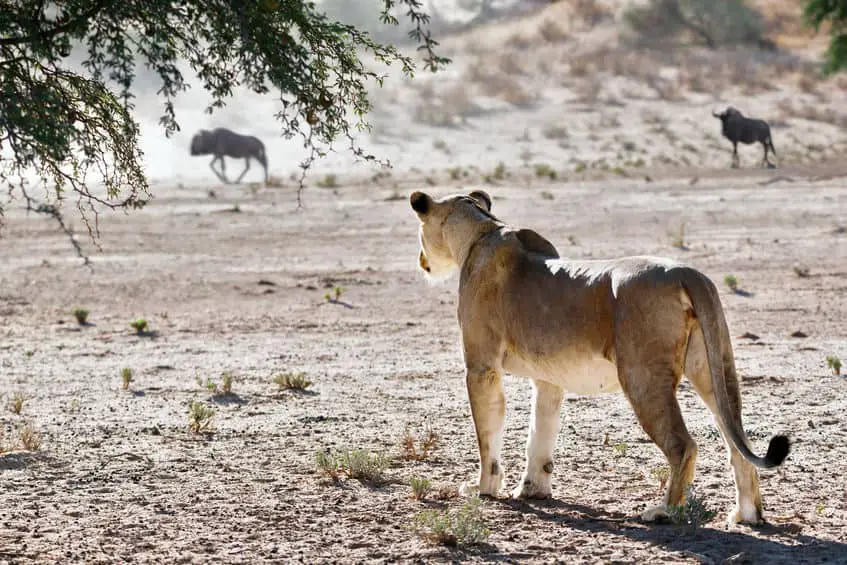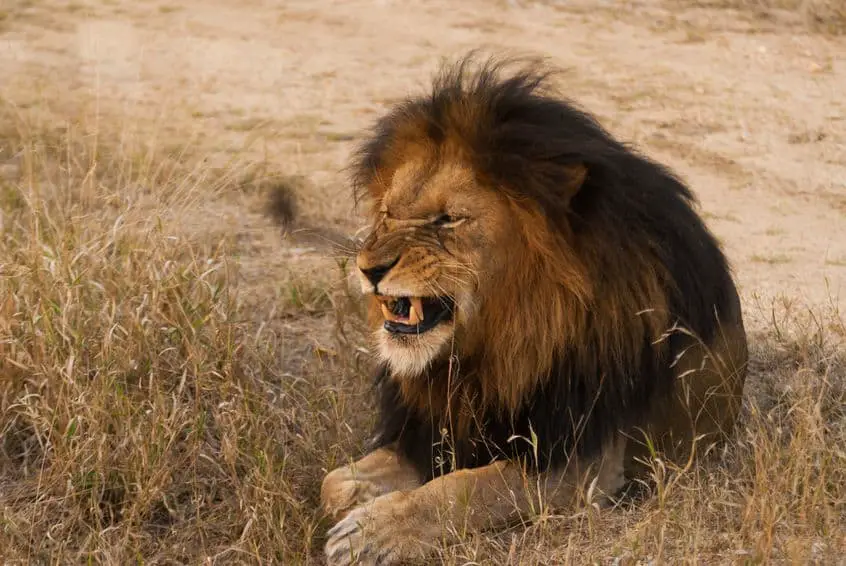
There are many differences between male and female lions. Some are physical and visible and some are found in their behavior. In this post, I have covered eight differences between male lions and lionesses including several of the lesser-known ones.
These are the eight differences I have described in detail in this post. I have purposely saved some of the more commonly known differences for last so we can get into the lesser-known differences right away.
- Different Roles And Social Behavior
- Different Responsibilities
- Different Hunting Behavior
- Different Scavenging Behavior
- Different Eating Behavior
- The Mane
- Different Lifespan
- Different Size
There is so much fascinating knowledge about how and why male lions and lionesses appear and behave differently. Let’s dive right into it!
1. Different Roles And Social Behavior
A group of lions is called a pride and both the roles within these prides and the social behavior varies greatly between male lions and lionesses. A pride of lions includes both males and females and usually consists of between 2-5 male lions and several more lionesses and their cubs. If the pride is very large, there are sometimes up to 9 male lions.
One of the most significant differences between male lions and lionesses is that male lions leave the pride they were born in when they are young and lionesses do not. The females in a pride are usually related to each other but not to the males.
Lions used to be widely distributed all over Africa but are only found in sub-Saharan Africa today. The largest prides of lions are generally found in eastern Africa. In the southern and western parts of Africa, the prides are usually significantly smaller with just a few members but they can, however, sometimes have up to around 15 members. The largest prides with 30 or even more members are mostly found in Kenya and Tanzania for example in the Serengeti National Park or the Masai Mara National Reserve.
Take a look at this incredible footage captured by a couple on a safari in Kruger National Park of South Africa where a massive pride of lions is walking right by their car on the road.
Prides of lions usually have between 10-20 members but can sometimes consist of up to as many as 40 lions. The size of a pride depends on several factors including the area in which they live and what types of food and how much of it is available in that area.
A pride of lions is formed when a group of male lions fights to gain control and power over a group of lionesses and cubs. When the fight is over and the lionesses have accepted the male lions, a full pride has been formed and the males are now the leaders, or owners, of the pride.
Lionesses usually stick to the pride they were born in for their entire lives. The lionesses and the cubs in a pride are usually all related to each other and can include members of up to five different generations. It usually includes mothers, grandmothers, aunts, and cousins.
Male lions on the other hand leave their family pride around the age of 2-4 and becomes nomads who move around over a large area until they are large and strong enough to acquire territory and a female pride of their own. They will often form small groups with other male lions and these small groups will most often consist of male lions that are related to each other such as brothers or cousins. They can, however, sometimes consist of male lions that are not related to each other but once such a group is formed, they will all treat each other as if they were related.
The primary reason why male lions form groups like this is to increase their ability to claim a group of lionesses and their territory. Male lions will also attempt to kill the cubs from previous males when trying to claim a group of lionesses. This will make the lionesses ready to have new cubs with the new male lions sooner.
Lionesses generally tend to become pregnant and give birth at the same time. This allows them to raise the cubs together and help each other which will increase the cubs’ chances of survival and also allow the cubs to have social relations with other cubs.
Male lions generally come and go and will not stay in a pride permanently. Lionesses on the other hand will stay and can sometimes keep their territory for many generations.
The responsibilities within these prides of lions are also very differently distributed between male lions and lionesses which we will get into now.
2. Different Responsibilities
It is safe to say that, despite males lions being higher in the hierarchy than lionesses (which we will get into very soon), the pride is centered around the lionesses. There are several reasons for this which we will take a look at now.
Lionesses are the primary hunters in their prides and are also the ones who take care of and raise the young cubs. Lionesses usually give birth to between 1-4 cubs each weighing 2-4 lb (1-2 kg). This makes the lionesses a completely invaluable part of the pride.
Despite this, lion prides are structured in a way where the small groups of male lions I mentioned just above actually own and lead the larger group of females and cubs.
Lions are extremely territorial animals and when lionesses take care of the cubs and the hunting, male lions are mostly in charge of protecting their pride and the territory
3. Different Hunting Behavior

African lions are considered to be nocturnal but many sources also categorize them as crepuscular. This means that lions are active primarily in the twilight period which is the time period between dawn and sunrise or between sunset and dusk.
Lions also hunt almost exclusively during the twilight period or at night.
Lionesses are the primary hunters of a pride. They are slightly smaller and significantly faster than the large, heavy male lions which makes them more efficient hunters.
Male lions are generally lazier than lionesses when it comes to hunting and mostly prefers for others to do the work for them. Sometimes, however, male lions can assist lionesses when they are hunting. Especially when they are trying to take down a large animal.
On their own, lions can hunt and take down animals as large as zebras or wildebeests but one of the major strengths lions benefit from is that they usually hunt together. When hunting in a group, lions can take down animals 10 times larger than themselves including large mammals such as hippos, white rhinoceroses, fully grown male cape buffalos or male giraffes, or sometimes even young male elephants. It is, however, rarer for lions to hunt elephants, hippos, and rhinos since they have extremely thick skin which makes them more difficult to overpower and eat for lions.
4. Different Scavenging Behavior
Lions mostly get their food from hunting but not exclusively. Like some other large African predators such as spotted hyenas or African wild dogs, lions are also scavengers who find and claim carrions in addition to hunting for food. In some areas of Africa, lions are reported to acquire as much as 40% of their food by scavenging. In other places, however, the number is as low as 5%.
Both male lions and lionesses scavenge but as I briefly mentioned above, it seems like male lions are more inclined to let other predators (or lionesses) do the work for them. This is also expressed when it comes to scavenging since it seems like male lions scavenge quite a bit more than female lions.
Lions find carrions by either listening for other scavengers such as spotted hyenas who are fighting over who gets to eat first or by observing vultures since these are also often an indication of where there is food to be found without having to hunt.
5. Different Eating Behavior
When it comes to eating, the hierarchy of a pride of lions truly comes into effect.
Male lions will almost always make sure that they get to eat before they let anybody else have any food. If the prey animal is small (meaning less than about 220 lb or 100 kg), they will make sure that they are full before allowing anybody else nearby.
If, however, their pride has taken down a very large animal such as a giraffe or a small elephant which contains plenty of food for everybody, the males will often let the lionesses and cubs eat right away.
Lionesses are quite the opposite of males and will almost always let their cubs eat first.
Now, let’s look at perhaps the most widely known difference between male and female lions.
6. The Mane

The mane is without a doubt, the most iconic and notable difference between male lions and lionesses.
Male lions have a large mane around their neck and head consisting of long golden fur. Lionesses have no such mane. The color of the male lions’ manes varies between different lions and can be lighter or darker in the color.
A large and dark mane expresses strength and power and is a result of a high level of testosterone. A lion with a large and dark mane is usually an alpha at the prime of its life who is strong, aggressive, and ready to fight.
Male lions with large and dark manes are not only strong but will also attract more lionesses as well as intimidate other male lions and allow them to take over territory or female prides easier.
When male lions become old or sick, their mane will start to change both color and volume and become lighter in color and smaller in size. So if you see a male lion on your safari, you can usually tell if it is a young male at the prime of his life or if it is an older lion by looking at the mane.
Male lions in captivity who get castrated will stop producing testosterone and will eventually lose their mane entirely.
7. Different Lifespan
Interestingly enough, there is actually a quite big difference in the average lifespan of male lions and lionesses. Just like with humans, the females tend to live a bit longer than the men (although the difference with lions is larger than with humans).
Male lions typically reach an age between 10-12 years but in some cases, they get up to 16 years old.
Lionesses usually reach an older age than male lions. The average lifespan of female lions is between 15-16 years but they can sometimes get up to 18 years old.
If cared for properly and given good living conditions, lions in captivity can live for up to 30 years.
How old each individual lion gets depends on many factors including what types of prey animals and how many of them are in the lion’s territory, how well the territory is structured for hunting, how much competition the lion has from other predators, and especially how many enemies the lion has to defend the territory and pride from.
8. Different Size
The last difference between male and female lions I have covered in this post is the size. Male lions are quite a bit larger than female lions. Sometimes even more than twice as large.
Male lions typically weigh between 400-440 lb (around 180-200 kg) but large males have been recorded weighing as much as 600 lb (272 kg).
Female lions have an average weight of around 290-310 lb (around 130-140 kg).
Just like with the lifespan, the size of each individual lion depends largely on many factors including the ones I mentioned in the section above about their lifespan.
Male lions are the second largest cats in the world after the Siberian tiger (also males). Female lions can get even larger than female Siberian tigers by up to 44 lb (20 kg) and are therefore the largest female cats in the entire world.
Male lions measure 5.6 to 8.3 feet (1.7-2.5 meters) in length and the females measure 4.6 to 5.7 feet (1.4-1.7 meters). When stretched out, the tail adds an extra 30 to 40 inches (76 to 102 cm) to these lengths.

